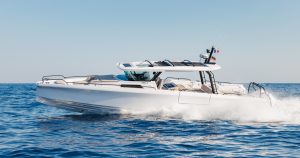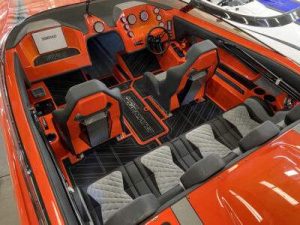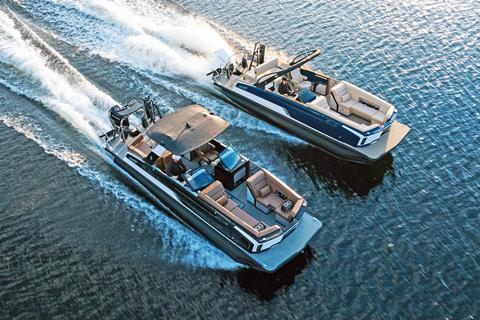Stevens Boats
Stevens Boats has long been a respected name in the boating community. Known for their range of models, these vessels cater to various needs and preferences. Whether you are interested in a moderate-priced boat or a high-end yacht, Stevens offers options spanning from around $63,354 to over $1.3 million. This diversity makes Stevens Boats a versatile choice for many buyers.
Renowned models like the 1040, 1140, 1180 S, 1380/1420, and the 1600 Dutch Steel Trawler showcase the brand's dedication to quality and performance. Each model is crafted with attention to detail, ensuring that buyers get a reliable and stylish boat. Stevens Boats are available worldwide, catering to clients in countries such as the United States, Greece, Spain, and others.
For those exploring the possibility of owning a Stevens boat, it's beneficial to know the options available through platforms like YachtWorld and Stephens Boats. These brokers provide listings and expert advice, making the purchasing process smoother and more informed.
Key Takeaways
- Stevens Boats offers a wide price range for various budget needs.
- Popular models include the 1040, 1140, and others.
- Boats can be found on platforms like YachtWorld.
History and Heritage
Stevens Boats, founded by Theodore and Robert Stevens, rose from a backyard project into a renowned boatbuilding firm. Their boats, like the 1180 S and 1600 Dutch Steel Trawler, are known for elegant design and quality craftsmanship.
Stevens Brand Evolution
The Stevens Brothers Boat Builders and Designers firm began in 1902 in Stockton, California. It quickly gained a reputation for beautifully crafted boats, first producing smaller vessels before expanding their range.
By the 1940s, they were known for their 63-foot Crash boats, used during World War II. Post-war, the brand continued to grow, designing a variety of pleasure craft. The company remained active until 1987, continually adapting and innovating their designs to meet changing market demands.
Iconic Stevens Models
Among their notable creations, the 1180 S stands out for its sleek design and functionality. The 1380/1420 models followed, boasting improvements in speed and comfort.
Another significant model is the 1600 Dutch Steel Trawler, known for its robust construction and suitability for long voyages. These models exemplify the craftsmanship and innovation that made Stevens Boats a trusted name in the boating world.
Boat Design and Specifications
Stevens Boats exemplify precise design and advanced specifications. Key aspects include innovative hull types, specific dimensions for sailing vessels, and features enhancing stability.
Hull Types and Materials
Stevens Boats use various hull types that contribute to their performance and durability. Common hull materials include wood, fiberglass, and aluminum. Each material offers distinct advantages, with wood providing a classic look and fiberglass offering durability and maintenance ease.
Some Stevens models feature a wider beam, enhancing stability and roominess. Deeper-depth drafts are also common, especially in designs meant for advanced sailing. These drafts help in achieving better balance and control in rough waters. The combination of materials and hull types ensures that Stevens Boats meet diverse sailing needs.
Sailing Vessel Dimensions
Stevens Boats are often praised for their well-thought-out dimensions. A Stevens sailboat like the Stevens 50 typically spans around 50 feet in length, making it suitable for long voyages. This length provides ample space for cabins, storage, and navigation equipment.
The beam width is crucial, providing stability. Stevens designs tend to have a wider beam, which not only increases stability but also creates more living space onboard.
Draft depth varies by model. Boats with adjustable keels can modify their draft to optimize performance in different water conditions. This adjustability provides versatility, ensuring the boat can handle both shallow and deep waters efficiently.
Boat Displacement and Stability
Displacement in Stevens Boats is carefully calculated to balance weight and buoyancy. A well-designed displacement helps the boat sit correctly in the water, ensuring better stability and handling. The weight distribution in Stevens Boats is precise, which is evident in their smooth sailing and responsive navigation.
Stability is further enhanced by features like wider beams and deeper drafts. These elements help maintain balance even in rough seas. Additionally, many Stevens Boats come equipped with ballast systems, which add weight below the waterline to improve stability and performance.
In summary, the combination of hull types, precise dimensions, and careful displacement calculations make Stevens Boats a popular choice among sailors, offering reliability and superior performance.
Engine and Propulsion
Stevens boats are known for their inboard drive power options and efficient diesel engines. These features contribute to their popularity among marine enthusiasts and professionals alike.
Inboard Drive Innovations
Stevens equips their models with advanced inboard drive power options. These inboard engines sit inside the boat, which offers a lower center of gravity and can enhance stability. This design also frees up deck space, making it ideal for social activities or fishing.
Inboard engines are usually connected to propeller shafts, offering direct propulsion. This setup minimizes the risk of props hitting submerged objects, reducing maintenance needs. It's a practical choice for those seeking a durable and reliable engine system.
In addition to operational benefits, inboard engines tend to be quieter. Their enclosed nature reduces noise levels, contributing to a more pleasant boating experience.
Diesel Engine Efficiency
Stevens boats also feature diesel propulsion systems known for their efficiency and power. Diesel engines often deliver better fuel economy compared to gasoline engines, making them ideal for long trips. This feature is crucial for avid boaters who venture on extensive voyages.
The high torque of diesel engines enables better handling and performance, especially in rough waters. This is because diesel fuel contains more energy per gallon, providing significant advantages in terms of both power and efficiency.
Furthermore, diesel engines typically have a longer lifespan. Their robust construction and ability to withstand heavy use make them a preferred choice for many boat owners. This longevity can translate into cost savings over the life of the boat.
Sailing Vessel Types and Uses
Sailing vessels come in various types designed for specific uses. These vessels are tailored for activities like long-distance cruising or high-speed racing.
Cruisers and Live-Aboards
Cruisers are designed for long-distance travel and living aboard. These boats are equipped with amenities like kitchens, sleeping quarters, and bathrooms. Popular cruiser types include the monohull and catamaran. Monohulls, such as the Stevens 47, provide smooth sailing even in rough seas.
Most cruisers feature either a sloop or cutter rig, allowing for easy handling and versatility. Sloops, with one mast and two sails, are simple and effective. Cutter rigs, with an additional sail, offer better balance and control. Cruising sailboats often have an aft cabin for extra sleeping space, making long voyages more comfortable.
Racing and Performance Crafts
Racing sailboats are built for speed and agility. These boats have sleek designs and lightweight materials to maximize performance. Common types include dinghies, sportboats, and offshore racers. Dinghies, like the Laser and Sunfish, are small and easy to maneuver.
Performance sailboats often use a planing hull, which skims over the water at high speeds. Sportboats, such as the Melges 24, are designed for competitive racing. Offshore racers are built to endure long-distance races over open seas. These vessels focus on minimal weight and optimal sail area to achieve maximum speed.
Whether it's the precision of a sloop rig or the distribution of a cutter rig, racing crafts are fine-tuned for competitive edge and speed.
Boat Ownership Insights
When considering boat ownership, key factors include whether to purchase a new or pre-owned vessel and the implications of different year models. Understanding these aspects helps make an informed decision.
New vs. Pre-Owned Purchases
Buying a brand-new vessel comes with certain perks. New boats often include warranties, which can provide peace of mind regarding potential repairs. Modern technology and features are typically more advanced in new boats, enhancing both comfort and performance.
Pre-owned yachts, on the other hand, offer affordability and may have valuable upgrades from previous owners. However, it's crucial to have a pre-owned boat thoroughly inspected to identify any hidden issues. Depreciation is less of a concern with pre-owned vessels, which can retain their value better than new ones.
Year Model Considerations
The year model of a boat plays a significant role in its condition and features. Older models might lack the latest technology and safety features but could be more robust in build quality. They often have a classic charm that appeals to certain buyers.
Newer models are generally aligned with current safety regulations and are equipped with the latest advancements in navigation and comfort. Buyers should consider the intended use of the boat and how crucial these modern features are. Whether you opt for a sleek new vessel or a vintage model, ensure it meets your needs and preferences.
Sales and Brokerage
Stevens boats and yachts are available through a range of brokers and specialized dealerships that offer expertise in sales and services. They are recognized for their design and quality, making them a sought-after option for boat enthusiasts.
Boat and Yacht Broker Overview
Boat and yacht brokers play a crucial role in the sale of Stevens boats. They act as intermediaries between buyers and sellers, facilitating negotiations and ensuring smooth transactions. Brokers have extensive knowledge of the market and are skilled in evaluating the condition and value of vessels.
Brokers handle all paperwork and legalities involved in buying or selling a yacht. They offer services that include marketing, sea trials, surveys, and handling offers. Notable brokers like United Yacht Sales often have listings for Stevens boats, providing a description and history of the specific yacht.
Brokerages maintain a network of professionals and have access to multiple listings, enhancing their ability to match buyers with the right boat. They ensure that all details and documentation are thoroughly checked, promoting a trustworthy transaction environment.
Specialized Dealerships
Specialized dealerships focus on specific brands, including Stevens yachts. These dealerships provide not only sales but also after-sales services such as maintenance and repairs. They have a deep understanding of the technical aspects and performance of Stevens boats, offering buyers confidence in their purchase.
Dealers like La Paz Cruisers Supply & Brokerage offer Stevens boats at various price points, ensuring a selection for different budgets. These dealerships often have a more tailored approach, helping clients find a boat that fits their precise needs.
These dealerships are known for their customer support and often provide additional services such as crew training, outfitting, and customization. Service centers associated with these dealerships ensure that the boats are well-maintained, adding to their longevity and performance.
Regional Markets
Stevens Boats caters to diverse markets with distinct preferences and trends. This section explores boating scenes in the United States, Europe, and Latin America, highlighting key areas and popular models.
United States Boating Scene
The United States boasts one of the largest and most active boating communities in the world. Popular coastal areas include Florida, California, and the Pacific Northwest.
Stevens Marine operates in locations like Tigard and Portland, Oregon, offering a range of new and used boats including brands like Alumaweld and Smokercraft. The variety in boat types, from fishing boats to leisure crafts, meets a broad range of needs and preferences.
Moreover, the financing and service options in regions such as Beaverton and Salem make boat ownership and maintenance more accessible. Frequent boating events and shows keep enthusiasts engaged.
European Market Overview
Europe's boating market is diverse, with distinct preferences in countries like the Netherlands, Portugal, and the United Kingdom.
In the Netherlands, Dutch Steel Trawlers by Stevens are particularly popular for their robust build and reliable performance. The presence of high-end models like the Stevens 1180 S and 1600 Dutch Steel Trawler reflect the demand for luxury and durability.
The United Kingdom sees a range of boats, from leisure yachts to more traditional and modern designs. Countries such as Greece and Spain also show significant demand for Stevens yachts, driven by a culture that values nautical leisure.
Boating in Latin America
Latin America, including Mexico, features a growing boating community with an increasing interest in both leisure and commercial vessels. Coastal regions like those along the Yucatán Peninsula offer ideal waters for boating enthusiasts.
While not as established as other markets, the demand for quality boats is rising. Consumers are looking for durable and versatile boats capable of handling both pleasure cruises and fishing activities.
Brands such as Stevens are gradually making their mark, thanks to their reputation for quality and customer service. The market is expected to grow as infrastructure and accessibility improve, opening new opportunities for boating enthusiasts in the region.
Boat Pricing and Value
When it comes to Stevens boats, prices can vary widely based on the model, year, condition, and location.
For instance, smaller models like the Stevens 1040 may start around $63,354, while larger, more luxurious models such as some 1380 models can cost up to $1,312,336. The condition of the boat is a significant factor affecting price, as a well-maintained boat will typically command a higher price.
Pricing tools like the NADA Guides, which were incorporated into J.D. Powers' valuation suite, can offer valuable insights into current market trends. These guides help buyers and sellers understand the fair market value of Stevens boats.
Key Factors Influencing Boat Value:
- Model: Different models have different value ranges.
- Year: Newer models tend to be more expensive.
- Condition: Boats in excellent condition are priced higher.
- Location: Prices vary by region due to demand and supply differences.
Websites like BoatCrazy provide tools to find the market value by entering the boat's details such as make, model, and year. This can help in making more accurate pricing decisions.
For detailed market analysis, tools like Boat Trader's Price Checker can be useful. They offer real-time market data for various boat conditions and ages, such as a 2012 Stevens model priced differently in various locations.
To ensure the best pricing, using a combination of these tools can help buyers and sellers navigate the market effectively.
Exploring Recreational Boating
Recreational boating offers diverse experiences from leisurely family outings to adventurous sailing trips. Whether you prefer calm lakes or exploring new coastlines, there’s something for everyone.
Family and Leisure Boating
Family and leisure boating is all about relaxation and enjoyment on the water. Many families enjoy spending time together on inland lakes such as Helen Lake, where they can swim, fish, or have a picnic on the boat. Activities like tubing and water skiing are popular as well.
Boats suited for family and leisure purposes often include pontoon boats, which offer ample space and comfort. These boats are ideal for families because they are stable and easy to handle. There are also options like small yachts for sale that provide additional amenities such as kitchens and sleeping quarters, making longer trips more enjoyable.
Safety is paramount in family boating. Modern boats come equipped with advanced navigation and safety systems, including precise GPS systems. It's essential to ensure everyone on board wears a life jacket and understands basic boating safety rules. Consider attending a boating safety course for additional confidence on the water.
Adventure and Travel Sailing
Adventure and travel sailing cater to those seeking exploration and excitement. This type of boating can involve longer trips on open waters, navigating through coastal areas, or even planning multi-day excursions. Enthusiasts often sail on boats like catamarans or sailing yachts, which offer both speed and comfort for extended travel.
Adventurous sailors might explore places like the Wisconsin River or other large water bodies that provide a mix of challenging conditions and beautiful landscapes. Such trips require good planning, including route mapping, weather forecasting, and proper equipment checks.
Sailing equipment has advanced significantly, with modern boats featuring state-of-the-art navigation tools. These include autopilots, radar, and communication systems that enhance safety and ease of travel. Adventure sailing is not just about reaching a destination; it’s also about the journey and the experiences along the way.
Notable Brokerage Platforms
This section covers essential information about YachtWorld Marketplace and Stevens Marine Presence, focusing on the key aspects that make these platforms notable in the boat brokerage industry.
YachtWorld Marketplace
YachtWorld Marketplace is a premier online platform where buyers and sellers connect for yacht transactions. Established as a trusted resource in the boating community, it offers an extensive inventory of yachts and boats from around the world.
YachtWorld provides in-depth listings, including detailed photos, specifications, and pricing information. Its advanced search functionality allows users to filter results based on a variety of criteria such as size, price, and location. This makes it easier for potential buyers to find what they are looking for.
Additionally, YachtWorld supports brokers with tools for managing listings and reaching a global audience. The platform's credibility and ease of use have made it a go-to resource for anyone looking to buy or sell yachts.
Stevens Marine Presence
Stevens Marine, based in Portland, Oregon, has a strong presence in the boat brokerage industry. Known for their expertise in both new and used boats, they have built a reputation for quality and customer service.
At their Portland location, Stevens Marine offers brokerage services that include evaluations, pricing strategies, and marketing plans tailored to each boat. Their experienced team helps customers navigate the complexities of buying or selling a boat, ensuring a smooth transaction.
Stevens Marine also features a wide selection of vessels, from fishing boats to luxury yachts. They are committed to maintaining an inventory that meets the diverse needs of their clients. Their local knowledge and industry connections make them a reliable choice for boat brokerage services in the region.
Identification and Documentation
Stevens boats can be identified and documented through several methods, including the use of boat tags and proper ownership paperwork. These elements ensure the boat's authenticity and legal standing.
Boat Tags and Identification
Stevens boats often feature specific tags that help in identifying the make, model, and year of the boat. These tags are typically placed on the inside of the transom. For example, a 1958 Stevens SK ski boat might have a metal tag indicating its number and details. These tags are crucial for boat enthusiasts who want to track the boat's history and verify its originality.
Additionally, some states issue new hull identification numbers when boats are sold or transported across state lines. Understanding and locating these tags can provide essential information about the boat's manufacturing and any modifications it might have undergone. This is especially important for restorations and maintaining the boat's value.
Ownership Paperwork and Registration
Proper paperwork is essential for proving ownership and registering the boat with the appropriate authorities. States like Washington use registration documents to include information such as USCG documentation numbers. These numbers are often found in fields that would typically contain state registration numbers.
Having detailed and correct paperwork not only legalizes the boat but also helps in documenting its history. Missing documents or incorrect registrations can lead to complications in the future, such as difficulty in selling the boat or legal issues. Therefore, retaining all original documents and updating registrations as needed is vital for any Stevens boat owner.
For more details, refer to examples on Performance Boats Forum and TugNuts.
Maintenance and Upkeep
Proper maintenance is essential for keeping a Stevens boat in good condition. Regular care can help prevent costly repairs and ensure a safe experience on the water.
Cleaning: Use mild soap and soft brushes to clean surfaces. A quality marine-grade wax should be applied at least twice a year to maintain gloss and UV protection.
Canvas Care: Keep canvas clean by brushing off dirt and using mild soap like Woolite or Dawn. Avoid washing or drying canvas in household machines, as it can damage the fabric.
Fuel System: Use high-quality, fresh fuel to maintain engine performance. Experts recommend scheduling regular fuel system maintenance to keep the boat running smoothly.
Gelcoat Maintenance: Address chips and cracks immediately to prevent further damage. Regular application of gelcoat wax will help protect against UV damage and maintain the boat's appearance.
Budgeting for Maintenance: Expect to pay $70 to $140 per hour for skilled work such as engine repair and electrical services. Unskilled projects like pressure-washing or waxing may cost around $40 to $80 per hour.
| Maintenance Task | Recommended Frequency | Estimated Cost |
|---|---|---|
| Waxing | Twice a year | $40 to $80 per hour |
| Engine Repair | As needed | $70 to $140 per hour |
| Canvas Cleaning | Regularly | DIY with mild soap |
For detailed maintenance tips, visit Boat Maintenance Guide: 11 Tips for Owners.
Prospective Buyer's Guide
When considering the purchase of a "Stevens Boat," potential buyers should weigh several key points.
New vs. Pre-Owned
New boats come with the latest technology, safety features, and a manufacturer's warranty. They provide a clean history and the excitement of being the first owner. Pre-owned boats, on the other hand, often cost less and offer more value for the price. You can get more boat for fewer dollars.
Key Considerations
Budget: Determine how much you are willing to spend. Include costs like insurance, storage, and maintenance. Remember that buying used can lower the initial cost but might require more maintenance.
Use: Think about how you plan to use the boat. Will you be fishing, skiing, or cruising? This will help you choose the right model and size.
Inspection: Inspect the boat thoroughly. Look for signs of decay or rot, especially in the transom and stringers. Consider hiring a marine surveyor for a detailed evaluation. You can find more tips on what to look for here.
Negotiating
Negotiation is a crucial part of the buying process. Be prepared to discuss the price and terms with the seller. You can find tips for negotiating boat prices here.
Paperwork
Ensure all paperwork is in order. This includes the title, registration, and any service records. Proper documentation will protect your purchase and make future transactions smoother.
Frequently Asked Questions
This section covers key details about Stevens boats, including their features, manufacturing locations, and tips for purchasing.
What are the distinctive features of the Stevens 47 sailboat?
The Stevens 47 sailboat is known for its robust design and ocean-going capabilities. It typically features a spacious cockpit, a large saloon, and high-quality materials. Owners appreciate its stability and performance in various weather conditions.
Where are Stevens boats manufactured?
Stevens boats are primarily manufactured in the United States. The company has a long history in American boat building, contributing to its reputation for quality and craftsmanship.
What types of boats are available at Stevens Marine?
Stevens Marine offers a variety of boats to suit different needs. These include sailboats, motorboats, and personal watercraft. They focus on both recreational and professional boating options, ensuring a wide range of choices for customers.
How does the market for used boats near Portland compare to other regions?
The used boat market near Portland is active, with many buyers and sellers. Prices are competitive, and there are often good deals available. Compared to other regions, Portland's market is known for having a diverse selection of boats, making it a popular area for buyers.
What should one look for when purchasing a used Stevens boat?
When buying a used Stevens boat, check for hull integrity, engine condition, and the state of the electrical systems. Also, inspect the sails and rigging on sailboats. It's important to review maintenance records and consider a professional survey to ensure the boat's overall condition.
How has the Stevens brand evolved over the years?
The Stevens brand has evolved by innovating and adapting to changes in boat building technology. They have modernized their designs while maintaining a focus on quality. This evolution has helped them stay relevant and popular among boating enthusiasts.

















